The 1937 Wheat Penny is a significant coin for both collectors of circulating coins and proof coins. It marks an important moment in the history of coinage, as it was the year mirror-like proofs were reintroduced after experimenting with Satin Finish proofs in 1936.
1937 Circulating Wheat Penny Value Chart
| Coin | MS 60 | MS 62+ | MS 64+ | MS 66+ | MS 67+ | MS 68 |
|---|---|---|---|---|---|---|
| 1937-D Wheat Penny | $6 | $9 | $22 | $52 | $650 | $13,000 |
| 1937-S Wheat Penny | $5 | $8 | $24 | $100 | $1,450 | $22,500 |
| 1937 (P) No Mint Mark | $4 | $7 | $22 | $60 | $725 | $10,500 |
1937 Proof Wheat Penny Value Chart
| Coin | PR/PF 58 | PR/PF 60 | PR/PF 62 | PR/PF 63+ | PR/PF 65 | PR/PF 67 |
|---|---|---|---|---|---|---|
| 1937 (P) Proof No Mint Mark Brown | $12 | $22 | $34 | $95 | $185 | – |
| 1937 (P) Proof No Mint Mark Red-Brown | – | $40 | $80 | $135 | $200 | $800 |
| 1937 (P) Proof No Mint Mark Red | – | $50 | $100 | $240 | $450 | $3,250 |
| 1937 (P) Proof No Mint Mark Cameo | – | $100 | $185 | $375 | $1,050 | $15,000 |
| 1937 (P) Proof No Mint Mark Deep Cameo | – | – | – | – | $4,500 | – |
History of the 1937 Wheat Penny
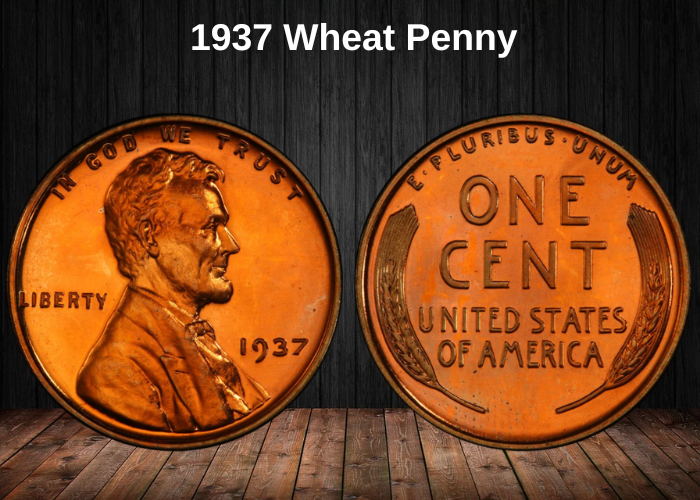
The 1937 Wheat Penny is a copper one-cent coin from the Lincoln Wheat Cent series, minted in the United States between 1909 and 1958. Designed by Victor David Brenner, the coin features the profile of President Abraham Lincoln on the obverse, while the reverse shows two wheat ears surrounding the inscription “ONE CENT,” symbolizing agricultural prosperity.
The year 1937 was part of the pre-World War II era, a time when the United States was slowly recovering from the Great Depression and beginning to experience industrial growth. Although no major political or economic events are directly tied to this specific coin, it reflects the era’s stability and the continued trust in the U.S. currency system.
The 1937 Wheat Penny was struck in three mints:
- Philadelphia (no mint mark)
- Denver (D mint mark)
- San Francisco (S mint mark)
All three versions had high mintage numbers, so the 1937 Wheat Penny is generally common and easy to find in circulated condition. However, collectors often seek well-preserved examples in uncirculated (MS) or proof-like condition, which can carry more value depending on the quality.
Although not rare, the 1937 Wheat Penny holds value for collectors due to its classic design, historical context, and role in American numismatics. It represents a time of transition, just before the major global changes that World War II would bring.
Features of the 1937 Wheat Penny
When talking about the parts of a coin, it’s important to use the proper terms. The front side, which usually displays a person or main image, is called the obverse. The back side is known as the reverse. The outer edge of the coin is simply referred to as the edge, while the raised border around both sides is called the rim or collar.
Any pictures or portraits on the coin are known as devices, and the flat background area behind them is the field. Lastly, any text or phrases on the coin are called legends or mottos.
The Obverse of the 1937 Wheat Penny
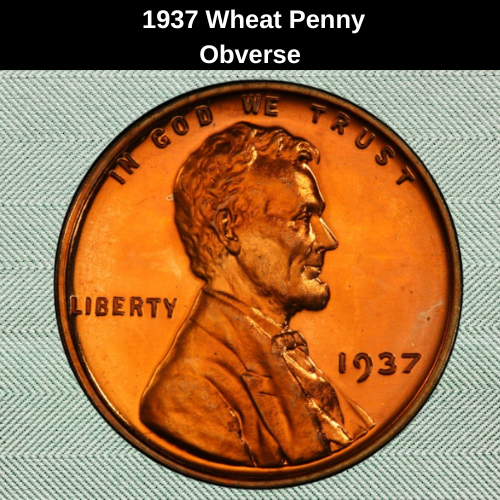
The obverse features a portrait of Abraham Lincoln, the 16th President of the United States, shown in profile facing to the right. The motto “IN GOD WE TRUST” arches above his head, while the word “LIBERTY” appears to his left. On the right side, you’ll find the minting year, and just beneath that, the mint mark (if present). If you look closely at the shoulder cutoff, you’ll see the initials “VDB”, representing the coin’s designer, Victor David Brenner.
The Reverse of the 1937 Wheat Penny
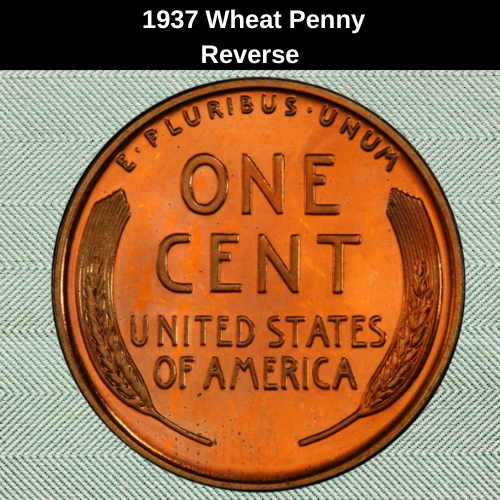
The reverse side displays two stylized wheat stalks, one on each side, curving upward to frame the design. Centered at the top, between the ears of wheat, is the motto “E PLURIBUS UNUM” in a moderate-sized font. The middle section of the coin features the bold inscription “ONE CENT”, indicating its denomination. Just below that, in smaller letters, is the name of the issuing country: “UNITED STATES OF AMERICA.”
Additional Details of the 1937 Wheat Penny
The 1937 Wheat Penny is composed of 95% copper, with the remaining 5% made up of zinc, tin, or a combination of both. It features a plain (smooth) edge, without any reeding. The coin weighs 3.11 grams and has a diameter of 19.05 millimeters (or 0.75 inches). Its color can be classified as red, red-brown, or brown, depending on its level of preservation and exposure to the elements.
1937 Wheat Penny Grading
As mentioned earlier, pennies are color-graded based on their surface appearance. Professional appraisal services like ANACS (American Numismatic Association Certification Service), NGC (Numismatic Guaranty Company), and PCGS (Professional Coin Grading Service) use the following codes:
- RD – Red (highest color grade; minimal oxidation, bright copper tone)
- RB – Red-Brown (moderate oxidation, some red and brown tones)
- BN or BRN – Brown (most oxidized, fully brown surface)
In addition to color, coins are graded numerically based on condition. Here’s a quick reference chart:
| Grade Number | Description |
|---|---|
| 1 | Basal State-1 |
| 2 | Fair |
| 3 | Very Fair |
| 4–6 | Good |
| 7–10 | Very Good |
| 12–15 | Fine |
| 20–30 | Very Fine |
| 40 | Extremely Fine |
| 50 | About Uncirculated |
| 60 | Mint State (Uncirculated) |
| 65 | Mint State (Gem) |
| 70 | Mint State (Perfect) |
👉 Tip: Always refer to an official grading guide to correctly identify your coin’s scale. It’s an essential step in determining the accurate value of your Wheat penny.
1937 Wheat Penny Value Guides
In 1937, Lincoln Wheat Pennies were minted at three different U.S. Mint facilities: Philadelphia (no mint mark), Denver (D), and San Francisco (S). During that time, proof coins were still exclusively struck at the Philadelphia Mint.
Occasionally, you may come across circulating coins that exhibit a reflective surface similar to proofs. These are designated:
- PL – Proof-Like
- DMPL – Deep Mirror Proof-Like
For actual proof coins, some of the finest examples display a strong contrast between the raised design (device) and the background (field). These high-contrast coins are graded:
- Cameo (CAM)
- Deep Cameo (DCAM) – the highest level of contrast
1937-D Wheat Penny Value
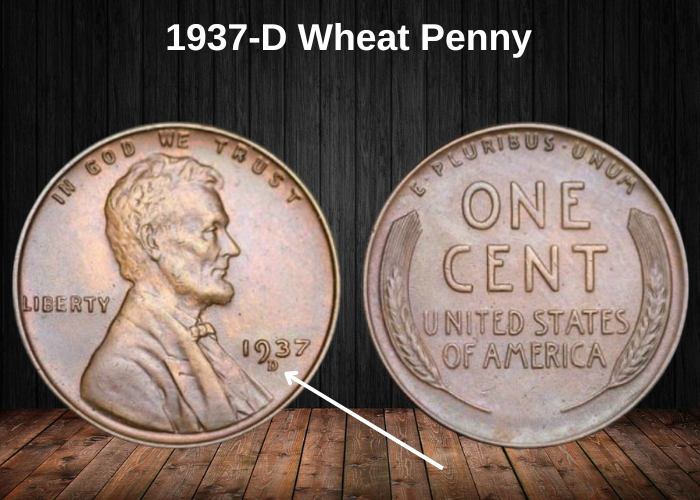
In 1937, the Denver Mint produced 50,430,000 Wheat Pennies, each bearing the “D” mint mark. These were business strikes (also known as regular strikes), meaning they were intended for everyday circulation.
Despite their intended use, some well-preserved examples have fetched impressive prices:
- A coin graded Uncirculated Details BN (Brown, but with damage) sold for $295 on eBay in 2021.
- A Mint State 65 Red-Brown (MS65 RB) example sold for $204 that same year.
- But the highest recorded sale was for a Mint State 68 Red (MS68 RD) specimen, which sold for $17,250 in 2006. Only 11 examples of this grade are known to exist.
1937-S Wheat Penny Value
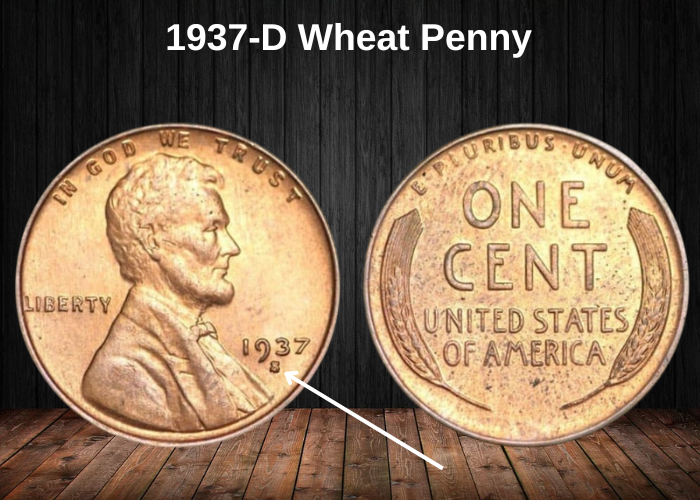
In 1937, the San Francisco Mint produced 34,500,000 Wheat Pennies, all of which were business strikes (regular circulation coins) and carried the distinctive “S” mint mark.
Although these coins were produced in large quantities, some high-quality examples have reached significant prices:
- An MS65 Brown (BN) example sold for $130 on eBay in 2018.
- A Genuine Red-Brown (RB) coin graded by NGC was sold for $123 in 2023.
- However, Heritage Auctions sold an MS67+ Red (RD) for $2,350 in 2014.
Since then, nearly 50 of those same-grade coins have surfaced, reducing their estimated value to $1,450 in 2024.
But a MS68 Red (RD) coin is currently valued at $22,500 due to its extreme rarity and quality.
1937 No Mint Mark Wheat Penny Value
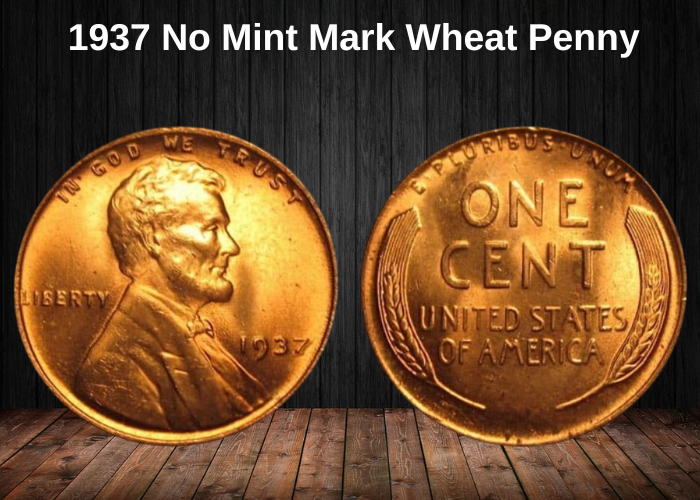
In 1937, the Philadelphia Mint produced both proof coins and business strikes. None of the coins from Philadelphia had a mint mark. The total production for the regular strike coins was 309,170,000, and these coins are generally not very expensive.
However, there are notable exceptions for high-quality examples:
- In August 2001, an AU55 Brown (BN) example sold for $690.
- An MS64 Red-Brown (RB) coin sold for $1,495 in March 2001.
- A top-quality MS68 Red (RD) coin sold for $7,200 in June 2019 and is now worth $15,500.
1937 (P) Proof No Mint Mark Wheat Penny Value
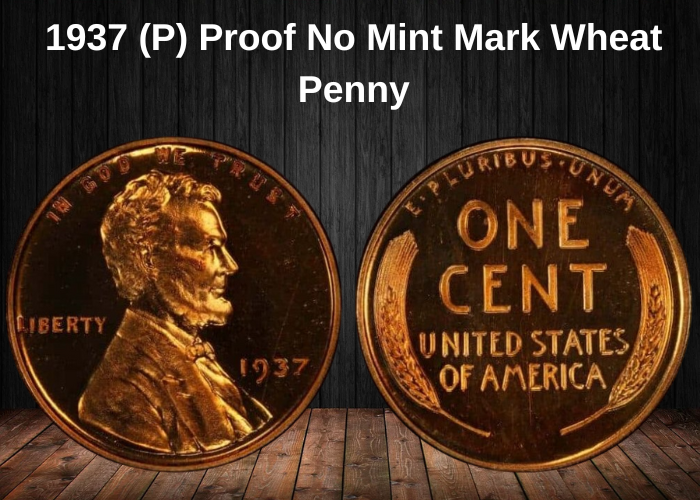
The Lincoln Wheat Penny was first minted in 1909, and it marked a significant change in U.S. coinage. At that time, proof coins were made using a matte finish. This was achieved by sandblasting the dies to create a hazy texture, which was necessary because the Lincoln Cents had a curved surface that didn’t lend itself well to mirror-like proofs.
Since the matte proofs required extra clarity, the mint hand-picked the best dies from the set, applied extra pressure during striking, and used the matte-proof dies for a shorter period before replacing them. Additionally, the matte-proof pennies were packaged in special sulphur-infused tissue paper to preserve their finish.
The matte proofs were minted from 1909 to 1917 and then the production of proof coins was halted for nearly two decades. In 1936, the mint resumed making proof coins but experimented with both mirror-like and satin-finish proofs (similar to the old matte proofs).
For the brilliant proofs, the mint used special dies that were scrubbed with horsehair brushes to give them a polished appearance. Later, these dies were treated with acid (or even computerized lasers in later years) to create a frosted finish on the devices (images, words, and other raised elements) for added contrast.
Types and Values of 1937 Proof Pennies
The acid pickling process used on coins creates a frosted appearance on the devices (raised designs), but over time, this shine tends to fade. Each time a die struck a planchet (coin blank), the contrast between the field (background) and the device would diminish slightly. As a result, the first 50 to 100 coins minted with a die were often graded as Ultra Cameo by NGC (Numismatic Guaranty Corporation) or Deep Cameo (DCAM) by PCGS (Professional Coin Grading Service). As more coins were minted, the contrast lessened, so the next coins were typically given the grade Cameo.
For the 1937 Wheat Penny, the Philadelphia Mint produced 9,320 proof coins. Some of the significant sales and grades for these coins include:
- A PR 67 BN sold for $2,853 on eBay in January 2023.
- Heritage Auctions sold a PR 64 RB for $4,094 in May 2004, but PCGS has graded nearly 100 of them at this level, so the current price is much lower, around $160 in August 2023.
- The highest grade reported by PCGS for a PR 67 RB is $800, but it is a unique piece.
- There are five PR 66 RB pennies priced at $350 each in August 2023.
For higher grades:
- A PR 68 RD sold for $13,800 in 2018.
- Three PR 67+ RD coins were priced at $13,500 each in 2023.
- A PR 67 CAM (Cameo) sold for $24,675 in 2019. With only six known examples, PCGS has priced these at $15,000 in 2023.
- A PR 67 DCAM (Deep Cameo) fetched $13,225 in 2009, but its value declined to $12,600 in 2019 and further dropped to $6,900 in 2020.
These prices highlight how rarity, condition, and quality of the cameo contrast (between the field and device) heavily influence the coin’s value.
Rare 1937 Wheat Penny Errors List
Mint errors can certainly make coins more valuable, especially if they are First Strike Errors, which are coins that are caught, confirmed, and certified within 30 days of the coin’s original release. These coins usually carry an FS number for identification. However, even if the errors are not classified as First Strike Errors, they can still significantly increase a coin’s value. Here are some common mint errors that can add value:
1937 (P) Penny Obverse Struck Through Fragment
A strike-through error happens when a foreign object (such as dirt, metal shavings, grease, or other debris) becomes trapped between the die and the blank (planchet) during the striking process. This contaminant either fuses with the coin or leaves an imprint of its shape on the coin’s surface.
In the case you mentioned, a metal shard caused a dent on Lincoln’s face. Such errors are highly collectible due to their rarity and the unique characteristics they add to the coin. In this instance, the coin was graded MS 63 BN (Mint State 63, Brown), and it sold for $515. If the coin were in a higher grade, its value would be much more due to the increased appeal and condition of the coin.
Factors That Influence the Value of Strike-Through Errors:
- Size and Location of the Error: The more noticeable and pronounced the strike-through is, the more valuable the coin is. A strike-through on a prominent feature like Lincoln’s face or the date would significantly increase the value.
- Coin Grade: As mentioned, a higher-grade coin will be worth more. A well-preserved error coin (such as MS 65 or MS 66) could be worth thousands, especially if the strike-through is significant.
- Rarity: Coins with unique or extremely rare strike-through errors are especially valuable. For example, a metal shard strike-through is a rare occurrence, making it more desirable among collectors.
1937 (P) Penny Struck 15% Off-Center
An off-center error occurs when the planchet (blank) is not aligned properly between the dies during the striking process. Ideally, the planchet should be positioned dead center between the two dies for the design to be fully and evenly imprinted on the coin. When the planchet is misaligned, only a portion of the surface receives the design imprint, leaving the rest of the coin unmarked or partially struck.
The degree of misalignment is often expressed in percentages. For example, if a coin is described as being 15% off-center, it means that the design is shifted and covers only 85% of the coin’s surface, leaving 15% of the coin blank or lacking the usual design.
Key Features of Off-Center Errors:
- Alignment Description: Off-center errors are typically described in percentages (such as 5%, 10%, 25%, etc.), indicating how much of the coin is affected by the misalignment.
- Grading: The grade of a coin with an off-center error is affected by both the degree of the misalignment and the overall condition of the coin. In this case, the coin was graded MS 64 RB (Mint State 64, Red-Brown), and it sold for $145.
- Collectibility: Off-center errors can be more valuable depending on their degree of misalignment and overall appeal. The more pronounced and noticeable the off-center error, the more desirable it is to collectors.
- Impact on Value: As with other mint errors, a higher grade and greater visual interest will typically result in a higher value. For example, an MS 64 off-center coin in Red-Brown can still have good market value, especially if the misalignment is noticeable and appealing.
In this case, the 15% off-center error, graded MS 64 RB, brought in $145, which is a reasonable price for a coin with a moderate off-center error. As the misalignment becomes more severe, or if the coin is in better condition, the value could increase significantly.
1937 (P) Penny Broadstruck
A broadstrike error occurs when the planchet (coin blank) is struck without the collar die, which normally helps form the coin’s rim and ensures the coin maintains its proper shape and thickness. Without the collar die, the metal spreads out more widely during striking, resulting in a coin that has a flattened or thinner rim, and the overall shape of the coin becomes larger than it should be. This type of error affects both the rim and the edge of the coin, making it appear “off” compared to a normal coin.
Key Features of Broadstrike Errors:
- Flattened Rim: Without the collar die, the rim of the coin is not properly formed, leading to a flattened or thinner rim, which is the primary indicator of this error.
- Wider Diameter: The absence of the collar also causes the coin to spread outward, making the coin appear wider than its standard size.
- Grading: Like other mint errors, a broadstrike coin is graded based on its condition. In this case, the coin was graded MS 66 BN (Mint State 66, Brown), indicating that it is in high-grade condition despite the broadstrike error.
- Value: Broadstrike errors can be valuable to collectors, especially when they are in excellent condition. The specific example you mentioned, graded MS 66 BN, sold for over $285. Higher-grade broadstrike coins, especially if the error is more pronounced or visually striking, can sell for significantly more.
Why Broadstrike Errors Are Valuable:
- Rarity: Broadstrike errors are relatively rare, as the collar die is an essential part of the coin-striking process. Coins that exhibit this error are interesting to collectors due to the unique nature of their production.
- Visual Appeal: Coins with pronounced broadstrike errors often have distinctive characteristics that attract collectors. The flattened rim and slightly altered shape can make these coins visually interesting and desirable.
- Condition: Higher-grade broadstrike coins, such as the MS 66 BN, are more valuable because they show little to no wear despite the minting error, preserving much of their original beauty and details.
In this case, the broadstrike penny was sold for over $285 due to its high-quality grade and the interest in mint errors among collectors.
Where to sell your penny?
Now that you know the value of your penny, you might be wondering where to sell it. Don’t worry: here’s a guide to some of the best online platforms where you can easily sell your coins, along with their advantages and disadvantages.
Discover the best platforms for selling coins online (pros and cons).
1937 Wheat Penny FAQ
1. What role does the 1937 Wheat Penny play in the broader context of U.S. coinage in the 1930s?
The 1937 Wheat Penny is part of a period where the United States was in the midst of economic recovery after the Great Depression. By 1937, the New Deal programs had begun to take effect, and the country’s economy was showing signs of improvement. This was reflected in the increasing mintage of coins, as currency demand grew. The 1937 penny is also interesting as it marked the final years of the Wheat Cent series before the introduction of the Lincoln Memorial design in 1959.
2. How did the mintage numbers for the 1937 Wheat Penny compare to other years during the 1930s?
The 1937 Wheat Penny had a relatively high mintage compared to other years in the 1930s:
- Philadelphia Mint (no mint mark): 157,098,000
- Denver Mint (D): 47,900,000
- San Francisco Mint (S): 28,670,000
Though the mintage of the 1937 penny was large, particularly in Philadelphia, high-quality uncirculated examples, especially those from San Francisco, are still highly sought after by collectors due to the relative scarcity of well-preserved coins.
3. What are the most valuable conditions and grades for the 1937 Wheat Penny?
Like many other Wheat Pennies, the 1937 penny is commonly found in circulated grades. Here are the typical price ranges for different conditions:
- Good to VG (very good): $1–$3
- Fine to Very Fine: $3–$10
- Extremely Fine: $10–$30
- Uncirculated (MS60 and above): Prices rise significantly with uncirculated examples, particularly for MS65 RD, which can reach $100 or more.
The highest premiums are paid for coins with Red (RD) color, particularly for MS65 RD or higher, which can range from $150 to $250 for the 1937-D or 1937-S in MS65 RD.
4. Are there any known varieties or errors associated with the 1937 Wheat Penny?
Although the 1937 Wheat Penny doesn’t have as many widely known varieties as other years, collectors do look for die cracks, re-punched mint marks (RPMs), and off-center strikes. These minor errors are common in the series, and coins with such errors, especially in high-grade condition, can attract premiums in the market. 1937-D and 1937-S pennies are particularly interesting for those looking for errors.
5. How does the strike quality of the 1937 Wheat Penny affect its value?
The strike quality of the 1937 penny plays a significant role in determining its value, especially for uncirculated examples. Coins from San Francisco tend to have softer strikes, particularly in the wheat stalks and Lincoln’s portrait. On the other hand, coins from Philadelphia and Denver are often better struck, though high-quality examples from all mints remain in demand. Coins with sharp details, minimal abrasions, and full red luster will command higher prices.
6. Why is the 1937 Wheat Penny a good investment coin for collectors?
The 1937 Wheat Penny, though not rare, is still a good investment for collectors looking for higher-grade specimens. Coins in uncirculated grades (MS65 RD) are particularly appealing as they become more difficult to find over time. The demand for well-preserved Red (RD) coins continues to grow, making this penny a solid choice for long-term investment, especially when considering the 1937-S or 1937-D in higher grades.
7. How does the 1937 Wheat Penny fit into a complete Wheat Cent collection?
For Wheat Cent collectors, the 1937 penny is an essential piece in completing a full set of Wheat Pennies (1909–1958). It is a common date in lower grades, but high-grade examples, especially those in MS66 RD or better, are always in demand by serious collectors. Including a well-preserved 1937 in a collection is critical for set builders aiming for completeness and quality.



















































